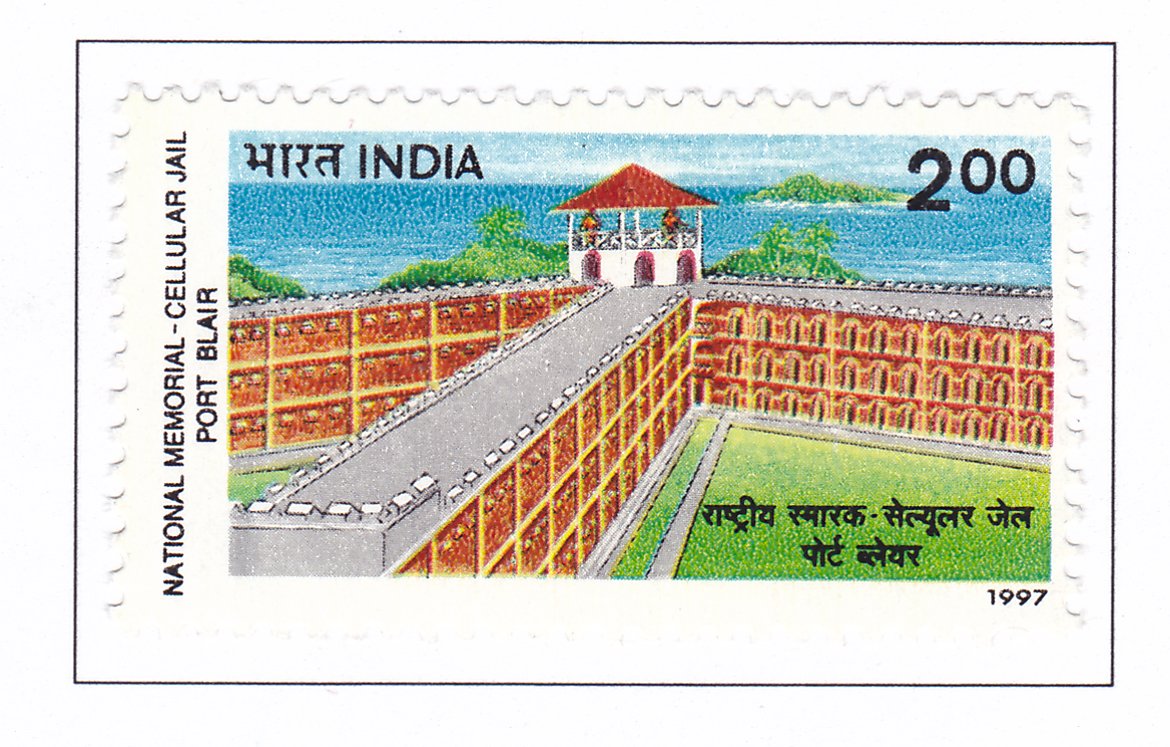National Memorial – Cellular Jail, Port Blair

Technical Data
| Date of Issue | December 20, 1997 |
|---|---|
| Denomination | Rs. 2 |
| Quantity | 700,000 |
| Perforation | comb 13 |
| Printer | Security Printing Press, Nashik |
| Watermark | No Watermark |
| Colors | Multicolor |
| Catalog Codes |
Michel IN 1602 Stamp Number IN 1663 Yvert et Tellier IN 1368 Stanley Gibbons IN 1766 |
| Themes | Buildings | Prisons |
Table of Contents
Commemorative Stamp: Cellular Jail, Port Blair
Historical Significance:
- The Cellular Jail, located in Port Blair, Andaman and Nicobar Islands, is a somber symbol of India’s fight for independence. Known as ‘Kala Pani’ (Black Waters), this jail was infamous for its inhumane treatment of freedom fighters who were imprisoned within its walls. The jail stands as a testament to the immense sacrifices made by these patriots and serves as a National Memorial, a place of pilgrimage for every Indian.
Architecture and Design:
- The jail’s name, Cellular Jail, originates from its unique architectural design. Unlike typical prisons, it had no dormitories; instead, it consisted of small individual cells, each measuring 13.5 feet by 7 feet. Each cell had an iron-grated door and a small ventilator positioned high above the door to minimize any interaction among prisoners. The layout was intentionally designed so that the front of each wing faced the back of another, further isolating the prisoners from each other.
Conditions and Sufferings:
- The British colonial government used the Cellular Jail to imprison those they deemed particularly dangerous. The prisoners endured unthinkable hardships, including inadequate and unfit food, lack of reading and writing materials, and heavily censored communication from the outside world. The harsh conditions drove many prisoners to madness or even suicide, as they could no longer bear the indignities and cruelties inflicted upon them.
Notable Freedom Fighters:
- Among the many who suffered in the Cellular Jail were prominent figures like Barindra Kumar Ghosh, Upendra Nath Banerjee, Hem Chandra Das, Indubhushan Roy, Ullaskar Datta, Bibhuti Bhushan Sarkar, and others involved in the Manicktollah Conspiracy.
- Vinayak Damodar Savarkar, known as Vir Savarkar, was one of the most notable freedom fighters incarcerated here, sentenced to transportation for life in 1910. Others included Prithvi Singh Azad, Bhai Parmanand, Vaman Joshi, and Shambu Nath Azad.
- Freedom fighters from the Chittagong Armoury Raid, the Meerut Conspiracy Case, and other revolutionary activities were also imprisoned in the jail.
Museum and Memorial:
- Today, the Cellular Jail houses a museum that preserves and displays photographs of the freedom fighters who were once imprisoned there. It also exhibits reports on the atrocities committed by the jail authorities, as published in national newspapers of that time. The museum showcases paintings depicting the barbarous treatment of prisoners, as well as utensils, uniforms, tools, and machines used by the prisoners, all serving as poignant reminders of the heroic struggles and immense sufferings endured by India’s freedom fighters.
Commemorative Stamp:
- The Department of Posts is proud to issue a special commemorative stamp of the Cellular Jail, honoring its significant place in India’s history of struggle for independence. This stamp serves as a tribute to the indomitable spirit of the freedom fighters who sacrificed their lives for the nation’s freedom.
